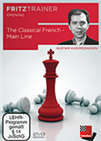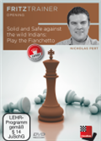Duda takes early lead
The 9th Danzhou Super Grandmaster Tournament went underway at the Baiyun Havana Resort Hotel in the town of Luzhou Guangcun in China on Friday. Featuring a field of eight young and promising Grandmasters from around the globe, the event promises some exciting games in its course. The time control is 90 minutes for the first 40 moves followed by 30 minutes for the rest of the game with a 30-second increment from move one.

This year's line-up of the Danzhou Masters | Photo: Official website
Round one saw most games end peacefully. Yu Yangyi versus Le Quang Liem and Wei Yi against Fedoseev were the first two games to finish and both were just dull draws. Bu Xiangzhi had some serious chances against Sam Shankland but missed opportunities led to an eventual draw. Jan-Krzysztof Duda was the only victor of the round who brought down Vidit Gujrathi of India and took an early lead in the tournament.
Vidit Gujrathi vs Jan Krzysztof Duda
This was that one game which game really stood out from the rest of the pack, not because it was the only decisive game of the round but because Duda went for broke to carve out a win in this one.
Vidit is a very difficult opponent to beat. In fact, Vidit hadn’t lost a single game this year before this one. He is always well prepared and hardly takes too much risk. But Duda pounced on the first opportunity he got in the game to unsettle his opponent.
 After 1.e4 e6 2.d4 d5 3. Nc3 Nf6 4. e5 Nfd7 5. f4 c5 6. Nf3 Nc6 7. Be3, the author takes a detailed look at a daring line with 7... cxd4 8. Nd4 Qb6, as well as the quieter plans with 7...cxd4 8. Nd4 Bc5, and the main line with 7... a6 and b5.
After 1.e4 e6 2.d4 d5 3. Nc3 Nf6 4. e5 Nfd7 5. f4 c5 6. Nf3 Nc6 7. Be3, the author takes a detailed look at a daring line with 7... cxd4 8. Nd4 Qb6, as well as the quieter plans with 7...cxd4 8. Nd4 Bc5, and the main line with 7... a6 and b5.
The Classical French seemed to have gone fine for both players. Neither side seemed to have anything to worry about. In the position above, white had just moved his rook to a1, trading off the only black piece that looked threatening. And after the obvious 23…Rxa1 24.Qxa1, Duda uncorked 24…Nxc3!
Even though this does not lead to a forced win, this is, perhaps, what was needed to unsettle an opponent like Vidit. The computers can scream equality all they want but after 25.Bxc3 Nxb4 26.Qb1 Nc6, blacks queenside pawn duo looks menacing. Vidit countered well on the kingside but faltered soon afterwards.
Here again, White is desperately trying to generate an initiative on the kingside. Duda came up with an ingenious solution to liquidate the position. He simply took the rook on g5 with his queen and then trapped the white queen with 41…Rg8. Quite incredibly, White is dead lost in this endgame despite being a whole piece up!

Duda came up with a gnarly tactic to unsettle his ever-solid opponent | Photo: Official website
Bu Xiangzhi vs Samuel Shankland
The man best known for having knocked out Magnus Carlsen from the World Cup last year, Bu Xiangzhi played an enterprising game with the white pieces against American GM Sam Shankland in the inaugural round. Giving up two pawns in a Fianchetto Gruenfeld, Bu generated some strong chances for himself in the middle game. By the 23rd move, he was even close to winning.
 The King''s Indian and Grunfeld are notoriously tricky and theoretical openings. The Fianchetto variation avoids the main lines which Black players enjoy, and goes for a small but safe edge. GM Nick Pert played the Fianchetto variation for over 20 years, and at the time of recording was unbeaten with White since November 2011!
The King''s Indian and Grunfeld are notoriously tricky and theoretical openings. The Fianchetto variation avoids the main lines which Black players enjoy, and goes for a small but safe edge. GM Nick Pert played the Fianchetto variation for over 20 years, and at the time of recording was unbeaten with White since November 2011!
Here, the Bu could have played 23.Nd3! and now, after 23…Nxd3, White has 24.Rb1. All of a sudden, the black queen is running out of squares. It can’t leave the long diagonal as Qe5+ would just be curtains and after 24…Qxc3 25.Rxd3 Qc6 26.Qe5+ Rf6, white is just clearly winning.
Bu missed this and played 23.Rxa6 instead which led to a more or less even position. But then Shankland again gave up an exchange, leaving himself with a rook and a knight against White’s queen and giving his opponent a winning position once again.
But once again, Bu failed to capitalize on his opponent’s mistakes and went on to draw in about fifteen more moves.

Bu Xiangzhi played enterprisingly but missed important serious winning opportunities against Sam Shankland | Photo: Official website
Wei Yi vs Vladimir Fedoseev
Wei Yi did come up with a novelty in the Bogo Indian but it hardly led him anywhere. Fedoseev quickly broke in the centre in response after which the Chinese GM had to acquiesce to a mass exchange of pieces which led to a barren position.
 1.d4 Nf6 2.c4 e6 3.Nf3 Bb4+ 4.Bd2 Qe7 5.g3 Bxd2!? 6.Qxd2 Nc6! 7.Nc3 d5! is a modern line where Black tries to play actively in the center. Shah shows the possible variations which occur in this position.
1.d4 Nf6 2.c4 e6 3.Nf3 Bb4+ 4.Bd2 Qe7 5.g3 Bxd2!? 6.Qxd2 Nc6! 7.Nc3 d5! is a modern line where Black tries to play actively in the center. Shah shows the possible variations which occur in this position.
Wei Yi and Vladislav Fedoseev agreed to a sedate draw in the opening round | Photo: Official website
Yu Yangyi vs Le Quang Liem
Yu Yangyi against Le Quang Liem was the first game to finish and this was no barnburner either. Here again, a mass exchange of pieces right out of the opening led the players into an equal endgame. For argument’s sake, black had an outside passed pawn. A couple of more exchanges drifted the game into an endgame with bishops of opposite colour wherein the players promptly agreed to a draw.

Yu Yangyi's game against Le Quang Liem was the first one to finish | Photo: Official website
Standings after Round 1
Links




























